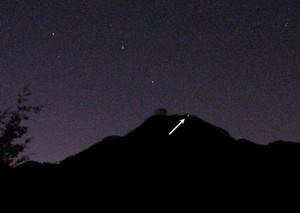Summary
NIST Stars is a project to improve the accuracy of the catalog of standard stars used by astronomers for spectral flux calibration of observatories so that they are SI traceable with uncertainty better than 0.5 %.
Description

Image of the NIST calibration source on the summit of Mt. Hopkins with the handle of the Big Dipper above.
Several current astrophysical research programs require SI traceable flux measurements (also called spectral irradiance) at accuracies higher than currently available. For example, exoplanet research requires improved host star absolute brightness knowledge to better determine habitability. Astrophysicists studying dark energy through supernova cosmology measurements require improved absolute spectral flux ratios over wide spectral ranges. These modern research areas and others are limited by the relatively large uncertainty currently available.
Currently, all SI traceable astronomical spectral flux measurements in the visible-near infrared are based on the calibration of a single star (Vega) performed through a series of experiments in the 1970's, and there are problems with extrapolating this visible-wavelength calibration into the infrared. More recent observations of Vega have led to questions about its suitability as a radiometric standard. Additionally, improvements since the 1970s in fundamental radiometry at NIST, and the ability to measure, model, and correct for the interfering effects of the Earth's atmosphere should allow for significant reduction in the radiometric uncertainties of stellar flux calibrations.
To calibrate the radiometric flux from a star, we use a system of calibrated detectors and sources. The first step is to calibrate a transfer spectrometer against a FEL lamp, whose calibration traces back to POWR (Primary Optical Watt Radiometer). This transfer spectrometer calibrates a light source which is then used to calibrate a telescope-spectrometer system in the NIST Telescope Calibration Facility (TCF). This last step defines the baseline response of the instrument. The telescope system, the transfer spectrometer and the light source are taken to an observatory and the telescope system is recalibrated in situ. Now the telescope measures the flux (spectral irradiance) of a star, thus transferring the calibration.
However, this gives only the ground-level radiometric flux, which varies with atmospheric conditions. To reliably measure the top-of-the-atmosphere stellar flux, we need to correct for the light lost in the atmosphere. This can be accomplished by using a LIDAR to determine the aerosol profile, a microwave radiometer to measure precipitable water vapor, in concert with atmospheric models to determine the atmospheric transmittance. Because the top-of-the-atmosphere flux does not vary for a stable star, repeated measurements under different atmospheric conditions will provide a measure of the uncertainty involved in this atmospheric correction.

